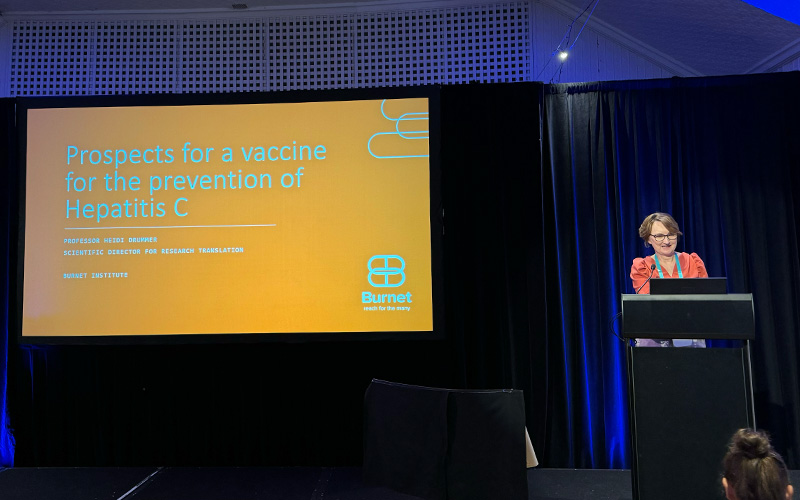
Fifty-eight million people around the world live with the chronic infection hepatitis C, including almost four million adolescents.
Hepatitis C leads to progressive liver damage and cancer. It is transmitted via contaminated blood, with 1.5 million new infections occurring each year.
Despite the availability of direct-acting antivirals that cure infections in more than 98 per cent of cases, a vaccine to prevent infection could help us reach elimination faster.
Burnet Scientific Director for Research Translation and Diagnostics Initiative, Professor Heidi Drummer, spoke about the prospects of a hepatitis C virus (HCV) vaccine at the Lorne Infection & Immunity conference last week.
Professor Drummer outlined the many approaches her group has explored towards the development of an effective vaccine against all prevalent variants of Hep C.
She said we are entering an exciting phase of HCV vaccine development.
"Together with innovative strategies to test vaccine efficacy ... new technologies using mRNA and lipid nanoparticle delivery mechanisms offer new avenues for developing a vaccine to prevent hepatitis C," she said.
Burnet researchers were well-represented at this year’s conference, with several taking part in the proceedings.
Burnet Senior Research Fellow Dr Lindi Masson presented her research on the fungal mycobiome in the female genital tract in young South African women, in collaboration with investigators at the University of Cape Town, and data analysis by Tamlyn Gangiah.
Vaginal fungal infection has been associated with susceptibility to HIV.
Dr Masson said the majority of studies have focussed exclusively on the most common vaginal fungal species, Candida.
“[Our] study identified relationships between other fungal species and HIV risk factors including sexually transmitted infections, bacterial vaginosis and inflammatory profiles,” she said.
"The vaginal mycobiome field is in its infancy, with a large proportion of fungal species still uncharacterised."
The event was also the annual meeting of the Australian Infectious Diseases Research Centre, and the Victorian Infection & Immunity Network (VIIN).
Burnet Head of Life Sciences Discipline, Professor Gilda Tachedjian chaired the Hertzog Oration and provided closing remarks as the network’s co-convener.
"I am thrilled that Burnet experts in virology and immunology are showcasing some of the amazing work we are doing in this space," she said.
"The conference is a premier annual meeting that attracts national and international leaders in microbiology and immunology to promote collaborations that can lead to impactful discoveries and practical health outcomes, as well as providing professional development opportunities for young scientists.”
Posters and presentations from Burnet researchers at the conference included:
- A population genomic model for measuring antigenic escape and predicting serotypes for malaria vaccine candidates - Professor Alyssa Barry, Honorary Principal Research Fellow
-
Inflammatory profiles of vaginal Gardnerella vaginalis isolates from South African women with and without bacterial vaginosis - Sarah Amir Hamzah, Honours student
-
A key Lactobacillus metabolite reduces HIV internalisation and migration through the cervicovaginal epithelial barrier - Brianna Jesaveluk, PhD student. Winner: Best Poster Presentation 2024
-
Genital InFlammation Test (GIFT) for sexual and reproductive health: point-of-care screening tool for sexually transmitted infections and bacterial vaginosis - Dr Lindi Masson, Senior Research Fellow
-
A new fluorescent tool to investigate a novel KoRV-related bat retrovirus - Dr Joshua A Hayward, Senior Research Officer and Shuoshuo Tian, Research Assistant
